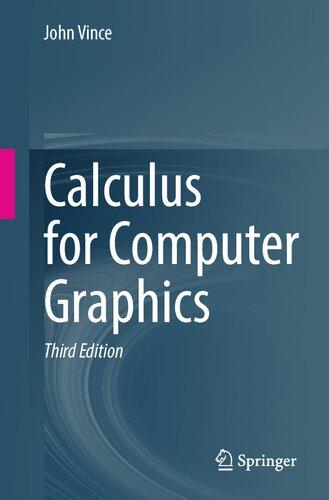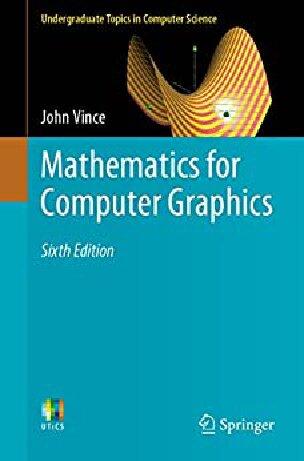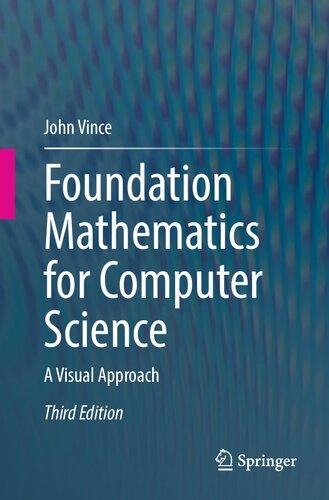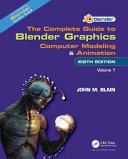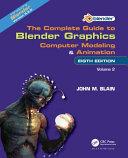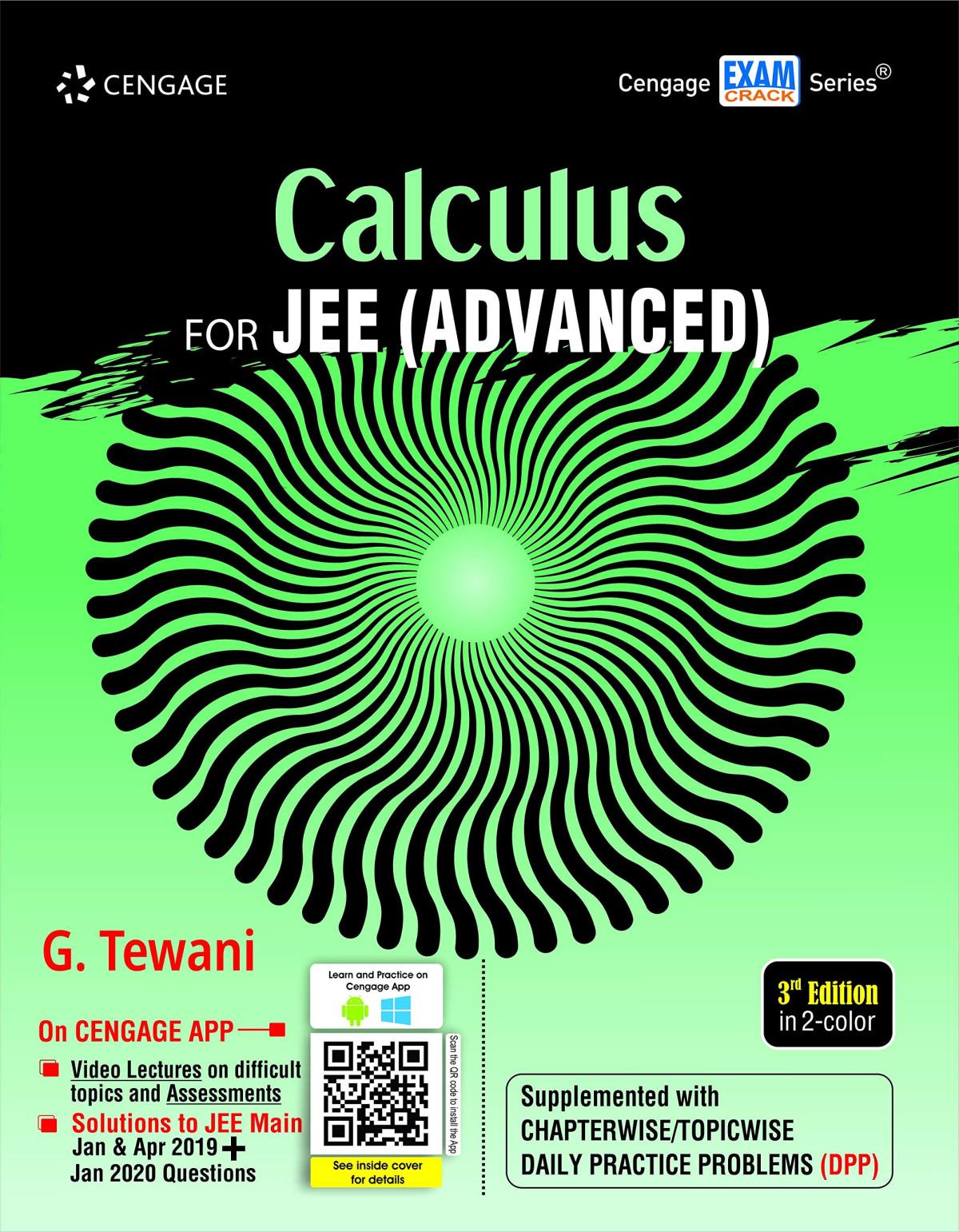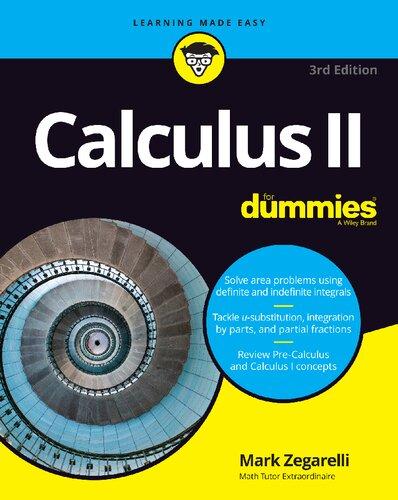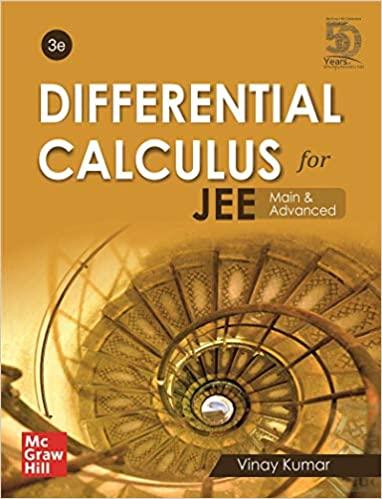JohnVince CalculusforComputer Graphics
ThirdEdition
JohnVince BournemouthUniversity Hereford,UK
ISBN978-3-031-28116-7ISBN978-3-031-28117-4(eBook) https://doi.org/10.1007/978-3-031-28117-4
1st edition:©Springer-VerlagLondon2013
2nd &3rd editions:©SpringerNatureSwitzerlandAG2019,2023
Thisworkissubjecttocopyright.AllrightsarereservedbythePublisher,whetherthewholeorpartof thematerialisconcerned,specificallytherightsoftranslation,reprinting,reuseofillustrations,recitation, broadcasting,reproductiononmicrofilmsorinanyotherphysicalway,andtransmissionorinformation storageandretrieval,electronicadaptation,computersoftware,orbysimilarordissimilarmethodology nowknownorhereafterdeveloped.
Theuseofgeneraldescriptivenames,registerednames,trademarks,servicemarks,etc.inthispublication doesnotimply,evenintheabsenceofaspecificstatement,thatsuchnamesareexemptfromtherelevant protectivelawsandregulationsandthereforefreeforgeneraluse.
Thepublisher,theauthors,andtheeditorsaresafetoassumethattheadviceandinformationinthisbook arebelievedtobetrueandaccurateatthedateofpublication.Neitherthepublishernortheauthorsor theeditorsgiveawarranty,expressedorimplied,withrespecttothematerialcontainedhereinorforany errorsoromissionsthatmayhavebeenmade.Thepublisherremainsneutralwithregardtojurisdictional claimsinpublishedmapsandinstitutionalaffiliations.
ThisSpringerimprintispublishedbytheregisteredcompanySpringerNatureSwitzerlandAG Theregisteredcompanyaddressis:Gewerbestrasse11,6330Cham,Switzerland
Preface
Calculusisoneofthosesubjectsthatappearstohavenoboundaries,whichiswhy somebooksaresolargeandheavy!SowhenIstartedwritingthefirsteditionofthis book,Iknewthatitwouldnotfallintothiscategory.Itwouldbearound200pages longandtakethereaderonagentlejourneythroughthesubject,withoutplacingtoo manydemandsontheirknowledgeofmathematics.
Thesecondeditionreviewedtheoriginaltext,correctedafewtypos,andincorporatedthreeextrachapters.Ialsoextendedthechapteronarclengthtoincludethe parameterisationofcurves.
Inthisthirdedition,Ihavereviewedthetext,correctedafewtypos,and incorporatednewchaptersonvectordifferentialoperatorsandsolvingdifferential equations.
Theobjectiveofthebookremainsthesame:toinformthereaderaboutfunctions andtheirderivatives,andtheinverseprocess:integration,whichcanbeusedfor computingareaandvolume.Theemphasisongeometrygivesthebookrelevance tothecomputergraphicscommunityandhopefullywillprovidethemathematical backgroundforprofessionalsworkingincomputeranimation,gamesandallieddisciplinestoreadandunderstandotherbooksandtechnicalpaperswherethedifferential andintegralnotationisfound.
Thebookdividesinto18chapters,withtheobligatorychapterstointroduceand concludethebook.Chapter 2 reviewstheideasoffunctions,theirnotationandthe differenttypesencounteredineverydaymathematics.Thiscanbeskippedbyreaders alreadyfamiliarwiththesubject.
Chapter 3 introducestheideaoflimitsandderivatives,andhowmathematicians haveadoptedlimitsinpreferencetoinfinitesimals.Mostauthorsintroduceintegration asaseparatesubject,butIhaveincludeditinthischaptersothatitisseenasan antiderivative,ratherthansomethingindependent.
Chapter 4 looksatderivativesandantiderivativesforawiderangeoffunctions suchaspolynomial,trigonometric,exponentialandlogarithmic.Italsoshowshow functionsums,products,quotientsandfunctionofafunctionaredifferentiated.
Chapter 5 covershigherderivativesandhowtheyareusedtodetectalocal maximumandminimum.
Chapter 6 coverspartialderivatives,whichalthougheasytounderstand,havea reputationforbeingdifficult.Thisispossiblyduetothesymbolsused,ratherthan theunderlyingmathematics.Thetotalderivativeisintroducedhereasitisrequired inalaterchapter.
Chapter 7 introducesthestandardtechniquesforintegratingdifferenttypesof functions.Thiscanbealargesubject,andIhavedeliberatelykepttheexamples simple,inordertokeepthereaderinterestedandontopofthesubject.
Chapter 8 showshowintegrationrevealstheareaunderagraphandtheconcept oftheRiemannSum.Theideaofrepresentingareaorvolumeasthelimitingsumof somefundamentalunitsiscentraltounderstandingcalculus.
Chapter 9 dealswitharclength,andusesavarietyofworkedexamplestocompute thelengthofdifferentcurvesandtheirparameterisation
Chapter 10 showshowsingleanddoubleintegralsareusedtocomputethesurface areaofdifferentobjects.ItisalsoaconvenientpointtointroduceJacobians,which, hopefully,Ihavemanagedtoexplainconvincingly.
Chapter 11 showshowsingle,doubleandtripleintegralsareusedtocompute thevolumeoffamiliarobjects.Italsoshowshowthechoiceofacoordinatesystem influencesasolution’scomplexity.
Chapter 12 coversvector-valuedfunctions,andprovidesashortintroductionto thisverylargesubject.
Chapter 13 isnew,andcoversthreedifferentialoperators:grad,divandcurl.
Chapter 14 showshowtocalculatetangentandnormalvectorsforavarietyof curvesandsurfaces,whichareusefulinshadingalgorithmsandphysically-based animation.
Chapter 15 showshowdifferentialcalculusisusedtomanagegeometriccontinuity inB-splinesandBéziercurves.
Chapter 16 looksatthecurvatureofcurvessuchasacircle,helix,parabolaand parametricplanecurves.Italsoshowshowtocomputethecurvatureof2Dquadratic andcubicBéziercurves.
Chapter 17 isnew,andexploresafewtechniquesforsolvingfirst-orderdifferential equations.
IusedSpringer’sexcellentauthor’s LATEX developmentkitonmyAppleiMac, whichissofastthatIcreateanentirebookin3or4seconds,justtochangeasingle character!Thisbookcontainsaroundtwohundredcolourillustrationstoprovide astrongvisualinterpretationforderivatives,antiderivativesandthecalculationof arclength,curvature,tangentvectors,areaandvolume.IusedApple’s Grapher applicationformostofthegraphsandrenderedimages,and Pages forthediagrams.
ThereisnowayIcouldhavewrittenthisbookwithouttheInternetandseveral excellentbooksoncalculus.OneonlyhastoGoogle‘WhatisaJacobian?’toreceive overathousandentriesinabout1second!YouTubealsocontainssomehighlyinformativepresentationsonvirtuallyeveryaspectofcalculusonecouldwant.SoIhave spentmanyhourswatching,absorbinganddisseminatingvideos,lookingforvital piecesofinformationthatarekeytounderstandingatopic.
ThebooksIhavereferredtoinclude: TeachYourselfCalculus byHughNeil, CalculusofOneVariable byKeithHirst, InsideCalculus byGeorgeExner, Short
Calculus bySergeLang, DifferentialEquations byAllanStruthersandMerlePotter, andmyall-timefavourite: MathematicsfromtheBirthofNumbers byJanGullberg. Iacknowledgeandthankalltheseauthorsfortheinfluencetheyhavehadonthis book.Oneotherbookthathashelpedmeis DigitalTypographyUsing LATEX by ApostolosSyropoulos,AntonisTsolomitisandNickSofroniou.
Writinganybookcanbealonelyactivity,andfindingsomeonewillingtoreadan earlydraft,andwhoseopiniononecantrust,isextremelyvaluable.Consequently,I thankDr.TonyCrillyforhisvaluablefeedbackafterreadingtheoriginalmanuscript. Tonyidentifiedflawsinmyreasoningandinconsistentnotation,andIhaveincorporatedhissuggestions.However,Itakefullresponsibilityforanymistakesthatmay havefoundtheirwayintothispublication.
Finally,IthankHelenDesmond,EditorforComputerScience,SpringerUK,for hercontinuingprofessionalsupport.
Breinton,Herefordshire,UK February2023
JohnVince
1Introduction ..................................................1
1.1WhatIsCalculus?........................................1
1.2WhereIsCalculusUsedinComputerGraphics?..............2
1.3WhoElseShouldReadThisBook?.........................3
1.4WhoInventedCalculus?...................................3
2Functions .....................................................5
2.1Introduction.............................................5
2.2Expressions,Variables,ConstantsandEquations..............5
2.3Functions...............................................6
2.3.1ContinuousandDiscontinuousFunctions.............7
2.3.2LinearGraphFunctions............................8
2.3.3PeriodicFunctions................................9
2.3.4PolynomialFunctions.............................10
2.3.5FunctionofaFunction.............................10
2.3.6OtherFunctions..................................11
2.4AFunction’sRateofChange...............................11
2.4.1SlopeofaFunction...............................11
2.4.2DifferentiatingPeriodicFunctions...................15
2.5Summary...............................................18
3LimitsandDerivatives .........................................19
3.1Introduction.............................................19 3.2SomeHistoryofCalculus.................................19
3.3SmallNumericalQuantities................................20
3.4EquationsandLimits.....................................21
3.4.1QuadraticFunction................................21
3.4.2CubicEquation...................................23
3.4.3FunctionsandLimits..............................25
3.4.4GraphicalInterpretationoftheDerivative............26
3.4.5DerivativesandDifferentials.......................27
3.4.6IntegrationandAntiderivatives.....................29
3.6.1LimitingValueofaQuotient1......................31
3.6.2LimitingValueofaQuotient2......................32
3.6.3Derivative.......................................32
3.6.4SlopeofaPolynomial.............................33
3.6.5SlopeofaPeriodicFunction........................33
3.6.6IntegrateaPolynomial.............................34
4DerivativesandAntiderivatives
4.1Introduction.............................................35
4.2DifferentiatingGroupsofFunctions.........................36
4.2.1SumsofFunctions................................36 4.2.2FunctionofaFunction.............................38 4.2.3FunctionProducts................................42
4.2.4FunctionQuotients................................45
4.2.5Summary:GroupsofFunctions.....................47
4.3DifferentiatingImplicitFunctions...........................48
4.4DifferentiatingExponentialandLogarithmicFunctions........52
4.4.1ExponentialFunctions.............................52
4.4.2LogarithmicFunctions.............................54
4.4.3Summary:ExponentialandLogarithmicFunctions....56
4.5DifferentiatingTrigonometricFunctions.....................57
4.5.1Differentiatingtan................................57
4.5.2Differentiatingcsc................................58
4.5.3Differentiatingsec................................59
4.5.4Differentiatingcot................................60
4.5.5Differentiatingarcsin,arccosandarctan..............61
4.5.6Differentiatingarccsc,arcsecandarccot..............62
4.5.7Summary:TrigonometricFunctions.................63
4.6DifferentiatingHyperbolicFunctions........................63
4.6.1Differentiatingsinh,coshandtanh..................66
4.6.2Differentiatingcosech,sechandcoth................68
4.6.3Differentiatingarsinh,arcoshandartanh.............70
4.6.4Differentiatingarcsch,arsechandarcoth.............72
4.6.5Summary:HyperbolicFunctions....................73
4.7Summary...............................................73
5HigherDerivatives ............................................75
5.1Introduction.............................................75
5.2HigherDerivativesofaPolynomial.........................75
5.3IdentifyingaLocalMaximumorMinimum..................78
5.4DerivativesandMotion...................................81
5.5Summary...............................................84
5.5.1SummaryofFormulae.............................84
6PartialDerivatives ............................................85
6.1Introduction.............................................85
6.2PartialDerivatives........................................85
6.2.1VisualisingPartialDerivatives......................88
6.2.2MixedPartialDerivatives..........................89
6.3ChainRule..............................................92
6.4TotalDerivative..........................................94
6.5Second-OrderandHigherPartialDerivatives.................95
6.6Summary...............................................95
6.6.1SummaryofFormulae.............................95
6.7WorkedExamples........................................96
6.7.1PartialDerivative.................................96
6.7.2FirstandSecond-OrderPartialDerivatives...........96
6.7.3MixedPartialDerivative...........................97
6.7.4ChainedPartialDerivatives.........................97
6.7.5TotalDerivative..................................98
7IntegralCalculus ..............................................101
7.1Introduction.............................................101
7.2IndefiniteIntegral........................................101
7.3StandardIntegrationFormulae.............................102
7.4IntegratingTechniques....................................102
7.4.1ContinuousFunctions.............................102
7.4.2DifficultFunctions................................104
7.4.3TrigonometricIdentities...........................104
7.4.4ExponentNotation................................108
7.4.5CompletingtheSquare............................108
7.4.6TheIntegrandContainsaDerivative.................110
7.4.7ConvertingtheIntegrandintoaSeriesofFractions....113
7.4.8IntegrationbyParts...............................114
7.4.9IntegratingbySubstitution.........................122
7.4.10PartialFractions..................................126
7.5Summary...............................................129
7.6WorkedExamples........................................130
7.6.1TrigonometricIdentities...........................130
7.6.2ExponentNotation................................130
7.6.3CompletingtheSquare............................130
7.6.4TheIntegrandContainsaDerivative.................131
7.6.5ConvertingtheIntegrandintoaSeriesofFractions....131
7.6.6IntegrationbyParts...............................132
7.6.7IntegratingbySubstitution.........................132
7.6.8PartialFractions..................................133
8AreaUnderaGraph
8.2CalculatingAreas........................................135
8.3PositiveandNegativeAreas...............................143
8.4AreaBetweenTwoFunctions..............................145
8.5Areaswiththe y -Axis.....................................147
8.6AreawithParametricFunctions............................148
8.7BernhardRiemann.......................................150
8.7.1DomainsandIntervals.............................150
8.7.2TheRiemannSum................................151
8.8Summary...............................................152
9.3.1ArcLengthofaStraightLine.......................156
9.3.2ArcLengthofaCircle.............................156
9.3.3ArcLengthofaParabola..........................157
9.3.4ArcLengthof y = x 3 2 .............................161
9.3.5ArcLengthofaSineCurve........................162
9.3.6ArcLengthofaHyperbolicCosineFunction.........163
9.3.7ArcLengthofParametricFunctions.................164
9.3.8ArcLengthofaCircle.............................165
9.3.9ArcLengthofanEllipse...........................166
9.3.10ArcLengthofaHelix.............................167
9.3.11ArcLengthofa2DQuadraticBézierCurve..........168
9.3.12ArcLengthofa3DQuadraticBézierCurve..........170
9.3.13ArcLengthParameterisationofa3DLine............172
9.3.14ArcLengthParameterisationofaHelix..............175
9.3.15PositioningPointsonaStraightLineUsing aSquareLaw....................................176
9.3.16PositioningPointsonaHelixCurveUsing aSquareLaw....................................178
9.3.17ArcLengthUsingPolarCoordinates.................179
9.4Summary...............................................182
9.4.1SummaryofFormulae.............................182
9.5WorkedExamples........................................183
9.5.1ArcLengthofaStraightLine.......................183
9.5.2ArcLengthofaCircle.............................184
9.5.3ArcLengthof y = 2 x 3 2 ............................184
9.5.4ArcLengthofaHelix.............................185 References....................................................186
10SurfaceArea ..................................................187
10.2.1SurfaceAreaofaCylinder.........................189
10.2.2SurfaceAreaofaRightCone.......................189
10.2.3SurfaceAreaofaSphere...........................192
10.2.4SurfaceAreaofaParaboloid.......................193
10.3SurfaceAreaUsingParametricFunctions....................195 10.4DoubleIntegrals.........................................197 10.5Jacobians...............................................198
10.7.1SummaryofFormulae.............................210 10.8WorkedExamples........................................212
10.8.1SurfaceAreaofaCylinder.........................212
10.8.2SurfaceAreaSweptOutbyaFunction...............212
10.8.3DoubleIntegrals..................................213
11.1Introduction.............................................215
11.2SolidofRevolution:Disks.................................215
11.2.1VolumeofaCylinder..............................216
11.2.2VolumeofaRightCone...........................217
11.2.3VolumeofaRightConicalFrustum.................219
11.2.4VolumeofaSphere...............................221
11.2.5VolumeofanEllipsoid............................221
11.2.6VolumeofaParaboloid............................223
11.3SolidofRevolution:Shells................................224
11.3.1VolumeofaCylinder..............................225
11.3.2VolumeofaRightCone...........................226
11.3.3VolumeofaHemisphere...........................227
11.3.4VolumeofaParaboloid............................228
11.4VolumeswithDoubleIntegrals.............................229
11.4.1ObjectswithaRectangularBase....................231
11.4.2RectangularBox..................................231
11.4.3RectangularPrism................................232
11.4.4CurvedTop......................................233
11.4.5ObjectswithaCircularBase.......................234
11.4.6Cylinder.........................................234
11.4.7TruncatedCylinder...............................235
11.5VolumeswithTripleIntegrals..............................236 11.5.1RectangularBox..................................237
11.5.2VolumeofaCylinder..............................238
11.5.3VolumeofaSphere...............................241
11.5.4VolumeofaCone.................................242 11.6Summary...............................................243
11.6.1SummaryofFormulae.............................243
11.7WorkedExamples........................................244
11.7.1VolumeofaCylinder..............................244
11.7.2VolumeofaRightCone...........................245
11.7.3QuadraticRectangularPrism.......................245 11.7.4CurvedTop......................................246
11.7.5CylinderwithaCurvedTop........................248
12Vector-ValuedFunctions .......................................249 12.1Introduction.............................................249
12.2DifferentiatingVectorFunctions............................249
12.2.1VelocityandSpeed................................250
12.2.2Acceleration.....................................252
12.2.3RulesforDifferentiatingVector-ValuedFunctions.....252
12.3IntegratingVector-ValuedFunctions........................253
12.3.1DistanceFallenbyanObject.......................254
12.3.2PositionofaMovingObject........................255 12.4Summary...............................................255
12.4.1SummaryofFormulae.............................255
12.5.1DifferentiatingaPositionVector....................256
12.5.2SpeedofanObjectatDifferentTimes...............257
12.5.3VelocityandAccelerationofanObject atDifferentTimes................................257
12.5.4DistanceFallenbyanObject.......................258 12.5.5PositionofaMovingObject........................258
13.4.1GradientofaScalarFieldin
13.4.3SurfaceNormalVectors............................270
13.8WorkedExamples........................................281
13.8.1GradientofaScalarField..........................281
13.8.2NormalVectortoanEllipse........................281
13.8.3DivergenceofaVectorField.......................283
13.8.4CurlofaVectorField.............................283
14TangentandNormalVectors ...................................285
14.1Introduction.............................................285
14.2Notation................................................285
14.3TangentVectortoaCurve.................................286
14.4NormalVectortoaCurve.................................288
14.4.1UnitTangentandNormalVectorstoaLine...........290
14.4.2UnitTangentandNormalVectorstoaParabola.......292
14.4.3UnitTangentandNormalVectorstoaCircle..........294
14.4.4UnitTangentandNormalVectorstoanEllipse........296
14.4.5UnitTangentandNormalVectorstoaSineCurve.....298
14.4.6UnitTangentandNormalVectorstoaCoshCurve.....300
14.4.7UnitTangentandNormalVectorstoaHelix..........302
14.4.8UnitTangentandNormalVectorstoaQuadratic BézierCurve.....................................303
14.5UnitTangentandNormalVectorstoaSurface................306
14.5.1UnitNormalVectorstoaBilinearPatch..............306
14.5.2UnitNormalVectorstoaQuadraticBézierPatch......307
14.5.3UnitTangentandNormalVectortoaSphere..........310
16.2.4ParametricPlaneCurve............................335
16.2.5CurvatureofaGraph..............................337
16.2.6Curvatureofa2DQuadraticBézierCurve............338
16.2.7Curvatureofa2DCubicBézierCurve...............339
16.4.1CurvatureofaCircle..............................342
16.4.2CurvatureofaHelix..............................342 17SolvingDifferentialEquations
17.2WhatIsaDifferentialEquation?............................343 17.3BasicConcepts..........................................344
17.5.2CompoundInterest................................355
17.5.3RadiocarbonDating...............................357
Chapter2 Functions
2.1Introduction
Inthischapterthenotionofafunctionisintroducedasatoolforgeneratingone numericalquantityfromanother.Inparticular,welookatequations,theirvariables andanypossiblesensitiveconditions.Thisleadstowardtheideaofhowfastafunction changesrelativetoitsindependentvariable.Thesecondpartofthechapterintroduces twomajoroperationsofcalculus:differentiating,anditsinverse,integrating.Thisis performedwithoutanyrigorousmathematicalunderpinning,andpermitsthereader todevelopanunderstandingofcalculuswithoutusinglimits.
2.2Expressions,Variables,ConstantsandEquations
Oneofthefirstthingswelearninmathematicsistheconstructionof expressions,such as2( x + 5) 2,using variables, constants andarithmetic operators.Thenextstep istodevelopanequation,whichisamathematicalstatement,insymbols,declaring thattwothingsareexactlythesame(orequivalent).Forexample,(2.1)istheequation representingthesurfaceareaofasphere
where S and r arevariables.Theyarevariablesbecausetheytakeondifferentvalues, dependingonthesizeofthesphere. S dependsuponthechangingvalueof r ,andto distinguishbetweenthetwo, S iscalledthe dependentvariable,and r the independent variable.Similarly,(2.2)istheequationforthevolumeofatorus
©SpringerNatureSwitzerlandAG2023
J.Vince, CalculusforComputerGraphics, https://doi.org/10.1007/978-3-031-28117-4_2
wherethe dependentvariableV dependsonthetorus’sminorradius r andmajor radius R ,whichareboth independentvariables.Notethatbothformulaeinclude constants4, π and2.Therearenorestrictionsonthenumberofvariablesorconstants employedwithinanequation.
2.3Functions
Theconceptofafunctionisthatofa dependentrelationship.Someequationsmerely expressanequality,suchas19 = 15 + 4,butafunctionisaspecialtypeofequationinwhichthevalueofonevariable(thedependentvariable)dependson,andis determinedby,thevaluesofoneormoreothervariables(theindependentvariables). Thus,intheequation
onemightsaythat S isafunctionof r ,andintheequation
V isafunctionof r and R . Itisusualtowritetheindependentvariables,separatedbycommas,inbrackets immediatelyafterthesymbolforthedependentvariable,andsothetwoequations aboveareusuallywritten
and
Theorderoftheindependentvariablesisimmaterial.
Mathematically,thereisnodifferencebetweenequationsandfunctions,itissimplyaquestionofnotation.However,whenwedonothaveanequation,wecanusethe ideaofafunctiontohelpusdevelopone.Forexample,noonehasbeenabletofind anequationthatgeneratesthe n thprimenumber,butIcandeclareafunction P (n ) thatpretendstoperformthisoperation,suchthat P (1) = 2, P (2) = 3, P (3) = 5, etc.Atleastthisimaginaryfunction P (n ),permitsmetomoveforwardandreflect uponitspossibleinnerstructure.
Amathematicalfunction must haveaprecisedefinition.It must bepredictable, andideally,workunderallconditions.
Weareallfamiliarwithmathematicalfunctionssuchassin x ,cos x ,tan x , √ x , etc.,where x istheindependentvariable.Suchfunctionspermitustoconfidently
writestatementssuchas
withoutworryingwhethertheywillalwaysprovideacorrectanswer.
Weoftenneedtodesignafunctiontoperformaspecifictask.Forinstance,ifI requireafunction y ( x ) tocompute x 2 + x + 6,theindependentvariableis x andthe functioniswritten
suchthat
2.3.1ContinuousandDiscontinuousFunctions
Understandably,afunction’svalueissensitivetoitsindependentvariables.A simple square-rootfunction,forinstance,expectsapositiverealnumberasitsindependent variable,andregistersanerrorconditionforanegativevalue.Ontheotherhand,a usefulsquare-rootfunctionwouldacceptpositiveandnegativenumbers,andoutput arealresultforapositiveinputandacomplexresultforanegativeinput.
Anotherdangerconditionisthepossibilityofdividingbyzero,whichisnot permissibleinmathematics.Forexample,thefollowingfunction y ( x ) isundefined for x = 1,andcannotbedisplayedonthegraphshowninFig. 2.1
whichiswhymathematiciansincludeadomainofdefinitioninthespecificationof afunction
Fig.2.1 Graphof y = ( x 2 + 1)/( x 1) showingthediscontinuityat x = 1
( x ) = x 2 + 1 x 1 for x = 1
Wecancreateequationsorfunctionsthatleadtoallsortsofmathematicalanomalies.Forexample,(2.3)createsthecondition0/0when x = 4
Similarly,mathematicianswouldwrite(2.3)as
Suchconditionshavenonumericalvalue.However,thisdoesnotmeanthatthese functionsareunsound—theyarejustsensitivetospecificvaluesoftheirindependent variable.Fortunately,thereisawayofinterpretingtheseresults,aswewilldiscover inthenextchapter.
2.3.2LinearGraphFunctions
Lineargraphfunctions areprobablythesimplestfunctionswewilleverencounter andarebaseduponequationsoftheform
Fig.2.2 Graphof y = 0.5 x + 2
Fig.2.3 Graphof y = 5sin x y = mx + c .
Forexample,thefunction y ( x ) = 0.5 x + 2isshownasagraphinFig. 2.2,where 0.5istheslope,and2istheinterceptwiththe y -axis.
2.3.3PeriodicFunctions
Periodicfunctions arealsorelativelysimpleandemploythetrigonometricfunctions sin,cosandtan.Forexample,thefunction y ( x ) = 5sin x isshownovertherange 4π< x < 4π asagraphinFig. 2.3,wherethe5istheamplitudeofthesinewave, and x istheangleinradians.
Fig.2.4 Graphof f ( x ) = 4 x 4 5 x 3 8 x 2 + 6 x 12
2.3.4PolynomialFunctions
Polynomialfunctions taketheform f ( x ) = an x n + an 1 x n 1 + an 2 x n 2 +···+ a2 x 2 + a1 x + a0
where n takesonsomevalue,and an areassortedconstants.Forexample,thefunction f ( x ) = 4 x 4 5 x 3 8 x 2 + 6 x 12isshowninFig. 2.4.
2.3.5FunctionofaFunction
Inmathematicsweoftencombinefunctionstodescribesomerelationshipsuccinctly. Forexample,thetrigonometricfunction f ( x ) = sin (2 x + 1)
isa functionofafunction.Herewehave2 x + 1,whichcanbeexpressedasthe function u ( x ) = 2 x + 1 andtheoriginalfunctionbecomes f (u ( x )) = sin (u ( x )).
Wecanincreasethedepthoffunctionstoanylimit,andinthenextchapterwe considerhowsuchdescriptionsareuntangledandanalysedincalculus.
2.3.6OtherFunctions
Youareprobablyfamiliarwithotherfunctionssuchasexponential,logarithmic, complex,vector,recursive,etc.,whichcanbecombinedtogethertoencodesimple equationssuchas
orsomethingmoredifficultsuchas
2.4AFunction’sRateofChange
Mathematiciansareparticularlyinterestedintherateatwhichafunctionchanges relativetoitsindependentvariable.Evenyouwouldbeinterestedinthischaracteristic inthecontextofyoursalaryorpensionannuity.Forexample,Iwouldliketoknow ifmypensionfundisgrowinglinearlywithtime;whetherthereissomesustained increasinggrowthrate;ormoreimportantly,ifthefundisdecreasing!Thisiswhat calculusisabout—itenablesustocalculatehowafunction’svaluechanges,relative toitsindependentvariable.
Thereasonwhycalculusappearsdaunting,isthatthereissuchawiderange offunctionstoconsider:linear,periodic,complex,polynomial,imaginary,rational, exponential,logarithmic,vector,etc.However,wemustnotbeintimidatedbysuch awidespectrum,asthemajorityoffunctionsemployedincomputergraphicsare relativelysimple,andthereareplentyoftextsthatshowhowspecificfunctionsare tackled.
2.4.1SlopeofaFunction
Inthelinearequation
y = mx + c
theindependentvariableis x ,but y isalsoinfluencedbytheconstant c ,which determinestheinterceptwiththe y -axis,and m ,whichdeterminesthegraph’sslope.
Fig.2.5 Graphof y = mx + 2fordifferentvaluesof m
3 y = -2x + 1 y = 0.5x2-2x + 1 y = 0.5x2
Fig.2.6 Graphof y = 0 5 x 2 2 x + 1showingitstwocomponents
Figure 2.5 showsthisequationwith4differentvaluesof m .Foranyvalueof x ,the slopealwaysequals m ,whichiswhatlinearmeans.
Inthequadraticequation
y = ax 2 + bx + c
y isdependenton x ,butinamuchmoresubtleway.Itisacombinationoftwo components:asquarelawcomponent ax 2 ,andalinearcomponent bx + c .Figure 2.6 showsthesetwocomponentsandtheirsumfortheequation y = 0 5 x 2 2 x + 1. Foranyvalueof x ,theslopeisdifferent.Figure 2.7 identifiesthreeslopesonthe graph.Forexample,when x = 2, y =−1,andtheslopeiszero.When x = 4, y = 1,
1
3 slope = slope2 = -2 slope=0
Fig.2.7 Graphof y = 0 5 x 2 2 x + 1showingthreegradients -3-2-10123456
Fig.2.8 Linearrelationshipbetweenslopeand x andtheslopelooksasthoughitequals2.Andwhen x = 0, y = 1,theslopelooks asthoughitequals 2.
Eventhoughwehaveonlythreesamples,let’splotthegraphoftherelationship between x andtheslope m ,asshowninFig. 2.8.Assumingthatothervaluesofslope lieonthesamestraightline,thentheequationrelatingtheslope m to x is
m = x 2.
Summarising:wehavediscoveredthattheslopeofthefunction
f ( x ) = 0 5 x 2 2 x + 1
changeswiththeindependentvariable x ,andisgivenbythefunction
f ( x ) = x 2.
Notethat f ( x ) istheoriginalfunction,and f ( x ) (pronounced fprime of x )isthe functionfortheslope,whichisaconventionoftenusedincalculus.
Rememberthatwehavetakenonlythreesampleslopes,andassumedthatthere isalinearrelationshipbetweentheslopeand x .Ideally,weshouldhavesampledthe graphatmanymorepointstoincreaseourconfidence,butIhappentoknowthatwe areonsolidground!
Calculusenablesustocomputethefunctionfortheslopefromtheoriginalfunction.i.e.tocompute f ( x ) from f ( x )
Readerswhoarealreadyfamiliarwithcalculuswillknowhowtocompute(2.6)from (2.5),butforotherreaders,thisisthetechnique:
1.Takeeachtermof(2.5)inturnandreplace ax n by nax n 1
2.Therefore0.5 x 2 becomes x .
3. 2 x ,whichcanbewritten 2 x 1 ,becomes 2 x 0 ,whichis 2. 4.1isignored,asitisaconstant.
5.Collectingupthetermswehave f ( x ) = x 2.
Thisprocessiscalled differentiating afunction,andiseasyforthistypeofpolynomial.Soeasyinfact,wecandifferentiatethefollowingfunctionwithoutthinking
Thisisanamazingrelationship,andisoneofthereasonswhycalculusissoimportant. Ifwecandifferentiateapolynomialfunction,surelywecanreversetheoperation andcomputetheoriginalfunction?Wellofcourse!Forexample,if f ( x ) isgivenby f ( x ) = 6 x 2 + 4 x + 6(2.7)
thenthisisthetechniquetocomputetheoriginalfunction:
1.Takeeachtermof(2.7)inturnandreplace ax n by 1 n +1 ax n +1 .
2.Therefore6 x 2 becomes2 x 3 .
3.4 x becomes2 x 2 . 4.6becomes6 x
Fig.2.9 Asinecurveovertherange0◦ to360◦
5.Introduceaconstant C whichmighthavebeenpresentintheoriginalfunction. 6.Collectingupthetermswehave
Thisprocessiscalled integrating afunction.Thuscalculusisaboutdifferentiating andintegratingfunctions,whichsoundsrathereasy,andinsomecasesitistrue.The problemisthebreadthoffunctionsthatariseinmathematics,physics,geometry, cosmology,science,etc.Forexample,howdowedifferentiateorintegrate
f ( x ) = sin x + x cosh x cos2 x ln x 3 ?
Personally,Idon’tknow,buthopefully,thereisasolutionsomewhere.
2.4.2DifferentiatingPeriodicFunctions
Nowlet’strydifferentiatingthesinefunctionbysamplingitsslopeatdifferentpoints. Figure 2.9 showsasinecurveovertherange0◦ to360◦ .Strictlyspeakingweshould beusingradians,whichimpliesthattherangeis0to2π .However,whenthescales fortheverticalandhorizontalaxesareequal,theslopeis1at0◦ and360◦ .Theslope iszeroat90◦ and270◦ ,and 1at180◦ .Figure 2.10 plotstheseslopevaluesagainst x andconnectsthemwithstraightlines. ItshouldbeclearfromFig. 2.9 thattheslopeofthesinewavedoesnotchange linearlyasshowninFig. 2.10.Theslopestartsat1,andforthefirst20◦ ,orso,slowly fallsaway,andthencollapsestozero,asshowninFig. 2.11,whichisacosinewave
